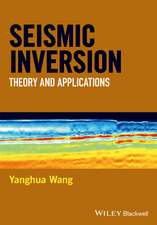Earthquake Early Warning Systems
Editat de Paolo Gasparini, Gaetano Manfredi, Jochen Zschauen Limba Engleză Hardback – 24 iun 2007
| Toate formatele și edițiile | Preț | Express |
|---|---|---|
| Paperback (1) | 942.90 lei 43-57 zile | |
| Springer Berlin, Heidelberg – 14 oct 2010 | 942.90 lei 43-57 zile | |
| Hardback (1) | 954.45 lei 43-57 zile | |
| Springer Berlin, Heidelberg – 24 iun 2007 | 954.45 lei 43-57 zile |
Preț: 954.45 lei
Preț vechi: 1163.97 lei
-18% Nou
Puncte Express: 1432
Preț estimativ în valută:
182.66€ • 189.99$ • 150.79£
182.66€ • 189.99$ • 150.79£
Carte tipărită la comandă
Livrare economică 14-28 aprilie
Preluare comenzi: 021 569.72.76
Specificații
ISBN-13: 9783540722403
ISBN-10: 3540722408
Pagini: 378
Ilustrații: XXIV, 350 p. 153 illus., 20 illus. in color.
Dimensiuni: 155 x 235 x 24 mm
Greutate: 0.7 kg
Ediția:2007
Editura: Springer Berlin, Heidelberg
Colecția Springer
Locul publicării:Berlin, Heidelberg, Germany
ISBN-10: 3540722408
Pagini: 378
Ilustrații: XXIV, 350 p. 153 illus., 20 illus. in color.
Dimensiuni: 155 x 235 x 24 mm
Greutate: 0.7 kg
Ediția:2007
Editura: Springer Berlin, Heidelberg
Colecția Springer
Locul publicării:Berlin, Heidelberg, Germany
Public țintă
ResearchDescriere
Seismic early warning is being recognized as a methodology which offers the biggest potential for real time seismic risk mitigation, particularly in towns and industrial areas. In order to be effectively applied it requires close cooperation between seismologists, communication experts and seismic engineers. The added value of this book is to offer an overview of frontier problems related to all aspects of the seismic early warning chain, from basic seismological issues to engineering problems and system reliability. Early warning seismic networks also provide near real time shake maps for damage estimation and emergency management immediately after an event. The state of the major early warning systems in operation and in the course of development (e.g. those operated in Japan, Taiwan, Rumania, Turkey and those being implemented in California and Southern Italy) is also presented. It is the first time that all these aspects are specifically focused upon within a single book. It will constitute a reference not only for researchers and students, but for all institutions which are willing to face the development and/or implementation of this methodology, including International organizations (UNDP, European Civil Protection, European Commision) National Civil Defence organizations, industry and town-planners.
Cuprins
Real-time Earthquake Damage Mitigation Measures.- Can Earthquake Size be Controlled by the Initial Seconds of Rupture?.- The ElarmS Earthquake Early Warning Methodology and Application across California.- Real-time Estimation of Earthquake Magnitude for Seismic Early Warning.- A New Approach to Earthquake Early Warning.- Optimal, Real-time Earthquake Location for Early Warning.- The Virtual Seismologist (VS) Method: a Bayesian Approach to Earthquake Early Warning.- A Strong Motion Attenuation Relation for Early-warning Application in the Campania Region (Southern Apennines).- Quantitative Seismic Hazard Assessment.- Seismic Early Warning Systems: Procedure for Automated Decision Making.- The Crywolf Issue in Earthquake Early Warning Applications for the Campania Region.- Earthquake Early Warning and Engineering Application Prospects.- UrEDAS, the Earthquake Warning System: Today and Tomorrow.- State of the Art and Progress in the Earthquake Early Warning System in Taiwan.- FREQL and AcCo for a Quick Response to Earthquakes.- Development and Testing of an Advanced Monitoring Infrastructure (ISNet) for Seismic Early-warning Applications in the Campania Region of Southern Italy.- An Early Warning System for Deep Vrancea (Romania) Earthquakes.
Notă biografică
Paolo Gasparini, is Full Professor of Geophysics at the University of Napoli Federico II and President of Center of Competence AMRA. He is Advisor for Environment to the EC Commissioner of Research. He was President of IAVCEI. His activities include the assessment of volcanic and seismic hazard and risk. He is on the steering committee of the EC SAFER project on seismic early warning.
Gaetano Manfredi, is Full Professor of Structural Design at the University of Napoli Federico II and Head of the Department of Structural Engineering. He is President of RELUIS (The Italian Network of University Seismic Engineering Labs) and a member of the Board of the Directors of AMRA. His activity is focused on seismic engineering and innovative materials. He is WP leader of the SAFER project.
Jochen Zschau is Full professor at the University of Potsdam and Director of the Department "Physics of the Earth" at the GeoForschungsZentrum Potsdam (GFZ). His scientific focus is on earthquake and volcanoes research. He was vice president of the European Seismological Commission. He is one of the leaders of the Indonesian-German Tsunami Early Warning System being set up in the Indian Ocean. He is coordinator of the EC SAFER project on seismic early warning.
Gaetano Manfredi, is Full Professor of Structural Design at the University of Napoli Federico II and Head of the Department of Structural Engineering. He is President of RELUIS (The Italian Network of University Seismic Engineering Labs) and a member of the Board of the Directors of AMRA. His activity is focused on seismic engineering and innovative materials. He is WP leader of the SAFER project.
Jochen Zschau is Full professor at the University of Potsdam and Director of the Department "Physics of the Earth" at the GeoForschungsZentrum Potsdam (GFZ). His scientific focus is on earthquake and volcanoes research. He was vice president of the European Seismological Commission. He is one of the leaders of the Indonesian-German Tsunami Early Warning System being set up in the Indian Ocean. He is coordinator of the EC SAFER project on seismic early warning.
Textul de pe ultima copertă
During the past few decades, economic losses and human casualties due to natural disasters increased exponentially on our planet, mainly because of the increased density of population and industry in high hazard areas. Although the prediction of earthquakes is not practicable yet, the present technology allows a prompt identification of the onset of any dangerous seismic event before it hits an urban area. Earthquake early warning can provide an alert within a few tens of seconds in advance. This small lead time may be used to minimize property damage and loss of lives in metropolitan areas and to aid emergency response. The book provides information on the major EEW systems in operation and on the state of the art of the different blocks forming an EW system: the rapid detection and estimation of the earthquake’s focal parameters, the signal transmission, the engineering interface and the information reliability/false alarm problem.
Caracteristici
Provides information on the major EEW systems in operation and on the state-of-the-art of the different blocks forming an EW system
The first time that so many aspects of EEW systems have been specifically focused upon within a single book
The first time that so many aspects of EEW systems have been specifically focused upon within a single book













